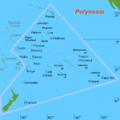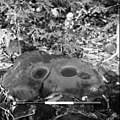Portal:Oceania
The Oceania PortalOceania (UK: /ˌoʊsiˈɑːniə, ˌoʊʃi-, -ˈeɪn-/ OH-s(h)ee-AH-nee-ə, -AY-, US: /ˌoʊʃiˈæniə, -ˈɑːn-/ ⓘ OH-shee-A(H)N-ee-ə) is a geographical region including Australasia, Melanesia, Micronesia, and Polynesia. Outside of the English-speaking world, Oceania is generally considered a continent, while Mainland Australia is regarded as its continental landmass. Spanning the Eastern and Western hemispheres, at the centre of the water hemisphere, Oceania is estimated to have a land area of about 9,000,000 square kilometres (3,500,000 sq mi) and a population of around 46.3 million as of 2024. Oceania is the smallest continent in land area and the second-least populated after Antarctica. Oceania has a diverse mix of economies from the highly developed and globally competitive financial markets of Australia, French Polynesia, Hawaii, New Caledonia, and New Zealand, which rank high in quality of life and Human Development Index, to the much less developed economies of Kiribati, Papua New Guinea, Tuvalu, Vanuatu, and Western New Guinea. The largest and most populous country in Oceania is Australia, and the largest city is Sydney. Puncak Jaya in Indonesia is the highest peak in Oceania at 4,884 m (16,024 ft). The rock art of Aboriginal Australians is the longest continuously practiced artistic tradition in the world. Most Oceanian countries are parliamentary democracies, with tourism serving as a large source of income for the Pacific island nations. (Full article...) Selected geographic article - New Caledonia (/ˌkælɪˈdoʊniə/ ⓘ KAL-ih-DOH-nee-ə; French: Nouvelle-Calédonie [nuvɛl kaledɔni] ⓘ) is a group of islands in the southwest Pacific Ocean, 220 km (140 mi) southwest of Vanuatu and 1,210 km (750 mi) east of Australia. Located 16,100 km (10,000 mi) from Metropolitan France, it forms a sui generis collectivity of the French Republic, a legal status unique in overseas France and enshrined in a dedicated chapter of the French Constitution. The archipelago, part of the Melanesia subregion, includes the main island of Grande Terre, the Loyalty Islands, the Chesterfield Islands, the Belep archipelago, the Isle of Pines, and a few remote islets. The Chesterfield Islands are in the Coral Sea. French people, especially locals, call Grande Terre le Caillou, a nickname also used more generally for the entire New Caledonia. Pro-independence parties refer to their country as (la) Kanaky coined in the 1980s after the Kanak, the collective name for its indigenous Melanesians who make up 41% of New Caledonia's population. New Caledonia is one of the European Union's Overseas Countries and Territories (OCTs), but it is not part of the European Union. (Full article...) Related portalsSelected article - Rongorongo (/ˈrɒŋɡoʊˈrɒŋɡoʊ/ or /ˈrɒŋoʊˈrɒŋoʊ/; Rapa Nui: roŋoroŋo [ˈɾoŋoˈɾoŋo]) is a system of glyphs discovered in the 19th century on Easter Island that has the appearance of writing or proto-writing. Numerous attempts at decipherment have been made, but none have been successful. Although some calendrical and what might prove to be genealogical information has been identified, none of the glyphs can actually be read. If rongorongo does prove to be writing and to be an independent invention, it would be one of very few inventions of writing in human history. Two dozen wooden objects bearing rongorongo inscriptions, some heavily weathered, burned, or otherwise damaged, were collected in the late 19th century and are now scattered in museums and private collections. None remain on Easter Island. The objects are mostly tablets shaped from irregular pieces of wood, sometimes driftwood, but include a chieftain's staff, a tangata manu statuette, and two reimiro ornaments. There are also a few petroglyphs which may include short rongorongo inscriptions. Oral history suggests that only a small elite was ever literate and that the tablets were sacred. (Full article...) Did you know -
General images -The following are images from various Oceania-related articles on Wikipedia.
TopicsSubcategoriesThings you can doAssociated WikimediaThe following Wikimedia Foundation sister projects provide more on this subject:
In other languagesWikipedia in other languages used in Oceania:
More portals
|




































































